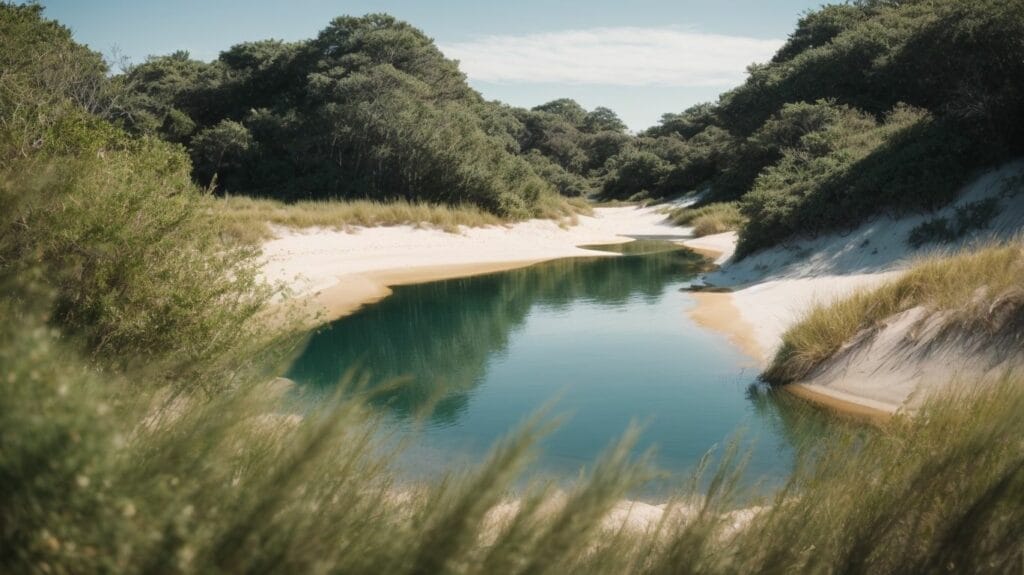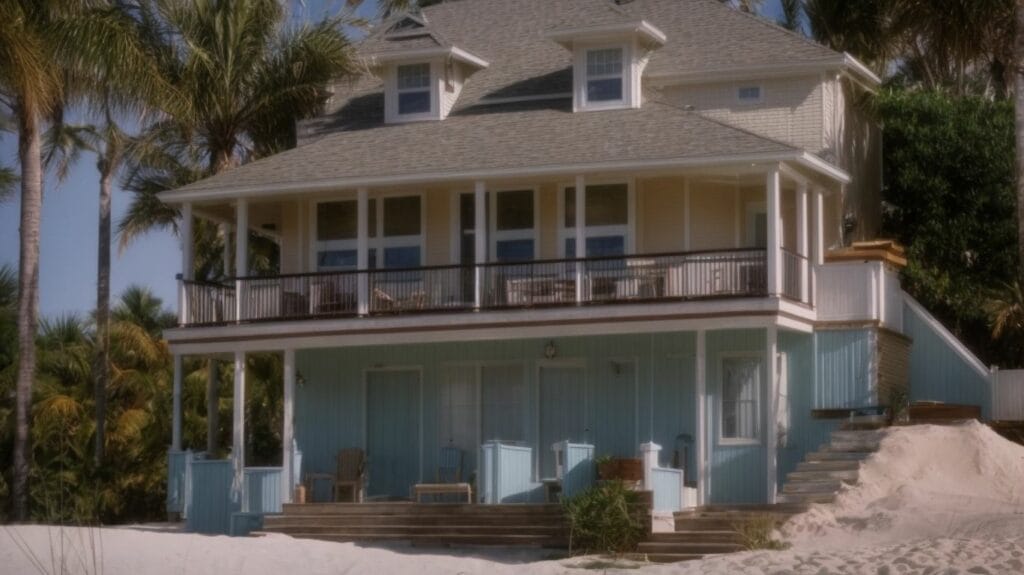Welcome to an in-depth exploration of the unique and mesmerizing coastal dune lakes of Florida’s 30A region. These stunning natural formations are a testament to the wonders of nature and play a vital role in the local ecosystem. In this article, we will delve into the formation of coastal dune lakes, the factors that contribute to their creation, and the distinctive characteristics that set them apart.
We will also take a closer look at the significance of South Walton’s coastal dune lakes, highlighting iconic spots for exploration and conservation efforts to protect these delicate ecosystems. We will explore the initiatives undertaken by conservation organizations to preserve the rich biodiversity of these lakes. As we embark on this journey, we will provide valuable insights into the geological wonders that can be found at Florida State Parks, the diverse wildlife that call coastal dune lakes home, and the vibrant engagement with the 30A community and its partners.
So, join us as we uncover the mysteries and marvels of coastal dune lakes, and gain a deeper understanding of their importance in the ecological tapestry of Florida’s enchanting landscapes.
Key Takeaways:
Understanding Coastal Dune Lakes in Florida
Coastal dune lakes in Florida are a unique phenomenon that combines the characteristics of freshwater and saltwater bodies, creating a diverse ecosystem that supports a wide range of wildlife and plant species.
These brackish water lakes are particularly significant for supporting a variety of both freshwater and saltwater species, making them a vital habitat for numerous bird species, fish, and aquatic plants. The interconnected ecosystems within the lakes’ protection zone play a crucial role in maintaining the delicate balance of marine and terrestrial life, providing a vital link between the coastal areas, the lakes, and the surrounding forests.
The Choctawhatchee Basin Alliance monitors and safeguards these freshwater sources, ensuring the conservation of these unique ecosystems and their continued support for the diverse flora and fauna that call them home.
Formation of Coastal Dune Lakes
The formation of coastal dune lakes is influenced by a combination of natural factors, including wind patterns, sand dune formations, and the interaction of rainfall, groundwater, streams, and tides along the coastal regions of Florida and the Gulf of Mexico.Exploring South Walton’s Coastal Dune Lakes
Exploring South Walton’s coastal dune lakes offers an enchanting experience as visitors encounter the unique blend of freshwater and saltwater environments, teeming with diverse wildlife and providing opportunities for activities such as bird watching, paddling, and fishing.Conservation Efforts for Coastal Dune Lakes
Conservation efforts for coastal dune lakes in Florida are paramount to safeguard the delicate ecosystems, preserve wildlife habitats, and ensure the sustainable protection of these unique natural entities, with organizations like the Choctawhatchee Basin Alliance leading initiatives in this crucial endeavor.Related Articles and Resources
Discovering articles and resources related to coastal dune lakes in Florida unveils valuable insights into the geological aspects, diverse wildlife, and the engagement of the 30A community in the conservation and appreciation of these natural wonders.Geological Insights at Florida State Parks
Exploring the geological insights at Florida state parks offers a deeper understanding of the formation and evolution of coastal dune lakes, shedding light on the geological processes that have shaped these unique natural features.At these state parks, visitors have the opportunity to observe the interplay of geological processes that have resulted in the creation of these coastal dune lakes. Studying the sediment layers, rock formations, and the interaction between groundwater and surface water provides valuable clues about the geological history of these lakes. The observations contribute to a comprehensive understanding of how these natural wonders have been molded over time, incorporating various geological elements and factors.
Discovering Wildlife in Coastal Dune Lakes
The exploration of wildlife in coastal dune lakes in Florida unveils a rich tapestry of ecosystems, offering captivating opportunities for bird watching and the observation of diverse avian species within these unique natural habitats.Florida’s coastal dune lakes are home to a myriad of bird species, including migrating shorebirds, magnificent herons, and colorful waterfowl. These stunning avian creatures thrive in the diverse ecosystems present around the dune lakes, attracting bird enthusiasts and wildlife photographers from around the world.
As the sun rises over the tranquil waters and pristine sand dunes, the melodic calls of various bird species fill the air, creating an enchanting symphony of nature. The coastal dune lakes provide an idyllic setting for observing the behaviors and interactions of these avian inhabitants, showcasing the intricate balance of life within these delicate ecosystems.
Engagement with 30A Community and Partners
The engagement with the 30A community and strategic partnerships plays a pivotal role in furthering the conservation efforts and promoting the appreciation of the diverse wildlife and ecosystems thriving within the realm of coastal dune lakes in Florida.By collaborating with local organizations and residents, the synergy achieved in conservation initiatives fosters a profound connection to the unique environment and its inhabitants. Building alliances with 30A businesses and institutions enhances the scope and impact of conservation projects, nurturing sustainable practices and harmonious coexistence with nature.
It’s through these partnerships that a greater understanding and respect for the coastal dune lakes and their ecological significance are fostered, laying the foundation for safeguarding these invaluable ecosystems for future generations.
Role of Winds in Formation
The role of winds in the formation of coastal dune lakes is instrumental, as the interaction between coastal winds and sand dunes contributes to the unique hydrological characteristics of these natural features.Coastal dune lakes are often nestled within or adjacent to the protective barrier islands along coastlines. The relationship between winds and dunes shapes these unique ecosystems, as prevailing wind patterns guide the movement of sand across the landscape, forming dunes that act as natural barriers and reservoirs for rainwater.
This interplay results in the formation of shallow depressions where these coastal dune lakes form, providing vital habitats for diverse flora and fauna within their distinct hydrological settings.
Depth and Characteristics
The depth and characteristics of coastal dune lakes in Florida, shaped by the influence of the Gulf of Mexico, play a crucial role in defining the distinct ecological and hydrological attributes of these natural formations.
Coastal dune lakes are a unique phenomenon, known for their dynamic interaction with the Gulf of Mexico. These rare freshwater bodies are nestled between sand dunes along the coastline, creating a delicate balance between freshwater and saltwater. The exchange of water and nutrients with the Gulf contributes significantly to the biodiversity and marine life in these coastal ecosystems. Their hydrological connectivity with the surrounding environment influences the water quality and sustains a diverse array of flora and fauna.
Significance of South Walton’s Coastal Dune Lakes
The significance of South Walton’s coastal dune lakes lies in their symbiotic blend of freshwater and saltwater environments, fostering diverse wildlife and offering a unique ecological landscape for exploration and conservation.These rare coastal dune lakes are characterized by their intersection with the Gulf of Mexico, allowing for the exchange of freshwater and saltwater, creating a delicate balance that supports a myriad of plant and animal species. The juxtaposition of different elements gives rise to ecosystems that are rich in biodiversity, making them a haven for birdwatching, fishing, and nature enthusiasts.
The lakes serve as vital breeding grounds for various species of fish and provide critical habitats for migratory birds, creating a thriving environment that contributes to the overall ecological health of the region. The ecological importance of these lakes has led to focused conservation efforts and the establishment of protected areas to ensure their preservation for future generations.
Iconic Spots for Exploration and Conservation
Several iconic spots for exploration and conservation within the realm of coastal dune lakes in Florida offer captivating experiences for engaging with the diverse wildlife, pristine ecosystems, and the conservation initiatives focused on preserving these natural wonders.The enchanting coastal dune lakes of Florida, including Western Lake, Campbell Lake, and Stallworth Lake, boast an array of unique habitats teeming with life. Visitors can immerse themselves in the tranquility of these pristine ecosystems, with opportunities to spot a variety of bird species, such as ospreys, herons, and egrets, as well as elusive mammals like bobcats and white-tailed deer. Many of these locations also serve as crucial nesting grounds for sea turtles, contributing to their conservation and preservation. Remarkably, ongoing efforts by local organizations and environmental groups continue to enhance the wildlife habitats and protect the delicate balance of these ecosystems.
Protecting Coastal Dune Lakes’ Ecosystem
The protection of coastal dune lakes’ ecosystems in Florida is imperative to safeguard the diverse wildlife, maintain ecological balance, and ensure the preservation of these unique natural habitats for future generations to cherish and appreciate.
These ecologically rich sanctuaries are home to a plethora of species, including rare plants, vibrant birdlife, and diverse aquatic fauna. Conservation efforts play a pivotal role in safeguarding these delicate ecosystems, not only for the sake of the wildlife that call them home but also to maintain ecological harmony.
The interconnectedness of these coastal dune lakes within the broader natural landscape further underscores the need for proactive conservation and preservation strategies. By protecting these habitats, we not only preserve the natural beauty but also secure the long-term sustainability of our environment.
Initiatives by Conservation Organizations
The initiatives undertaken by conservation organizations such as the Choctawhatchee Basin Alliance play a pivotal role in implementing conservation measures, preserving wildlife habitats, and raising awareness about the ecological significance of coastal dune lakes in Florida.These proactive initiatives involve a multi-faceted approach, including habitat restoration, water quality monitoring, and educational outreach programs. The Choctawhatchee Basin Alliance has been at the forefront of these efforts, partnering with local communities, government agencies, and other environmental organizations to ensure the long-term sustainability of these unique ecosystems.
Plus their conservation efforts, the alliance actively engages with the community, organizing volunteer clean-up events, nature walks, and citizen science projects to foster a deeper connection to the coastal dune lakes and their surrounding environments.
Frequently Asked Questions
What are 30A Coastal Dune Lakes?
30A Coastal Dune Lakes are rare and unique bodies of water found along the coast of the Florida Panhandle. These lakes are formed by a combination of freshwater from creeks and streams and saltwater from the Gulf of Mexico, creating a diverse ecosystem.
How many 30A Coastal Dune Lakes are there?
There are a total of 15 recognized 30A Coastal Dune Lakes, all located along the scenic Highway 30A in Walton County, Florida.
What makes 30A Coastal Dune Lakes special?
30A Coastal Dune Lakes are one of the few places in the world where freshwater and saltwater mix. This creates a unique environment that is home to a variety of plants and animals, many of which are rare or endangered.
Can you swim in 30A Coastal Dune Lakes?
Yes, swimming is allowed in 30A Coastal Dune Lakes. However, it is important to practice responsible recreation, such as avoiding disturbing the natural habitat and not using motorized boats in the lakes.
Are there any activities to do at 30A Coastal Dune Lakes?
There are plenty of activities to enjoy at 30A Coastal Dune Lakes, such as fishing, kayaking, paddleboarding, and hiking. These lakes also offer opportunities for birdwatching and wildlife viewing.
Is there any conservation efforts for 30A Coastal Dune Lakes?
Yes, there are ongoing conservation efforts to protect and preserve 30A Coastal Dune Lakes. Local organizations and agencies work together to monitor the lakes, educate the public, and implement conservation strategies to maintain the delicate balance of this unique ecosystem.





